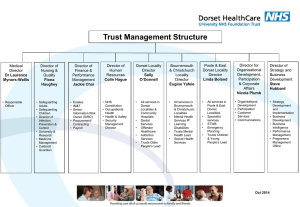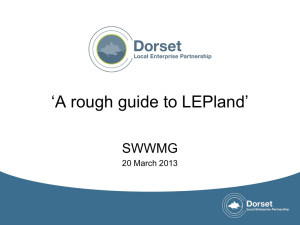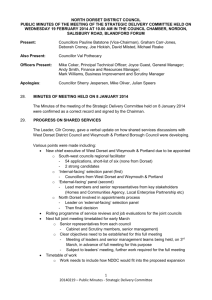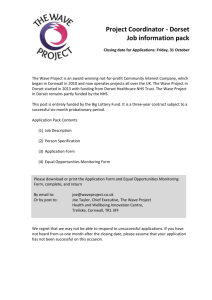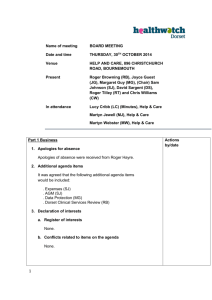Communication Strategy
advertisement
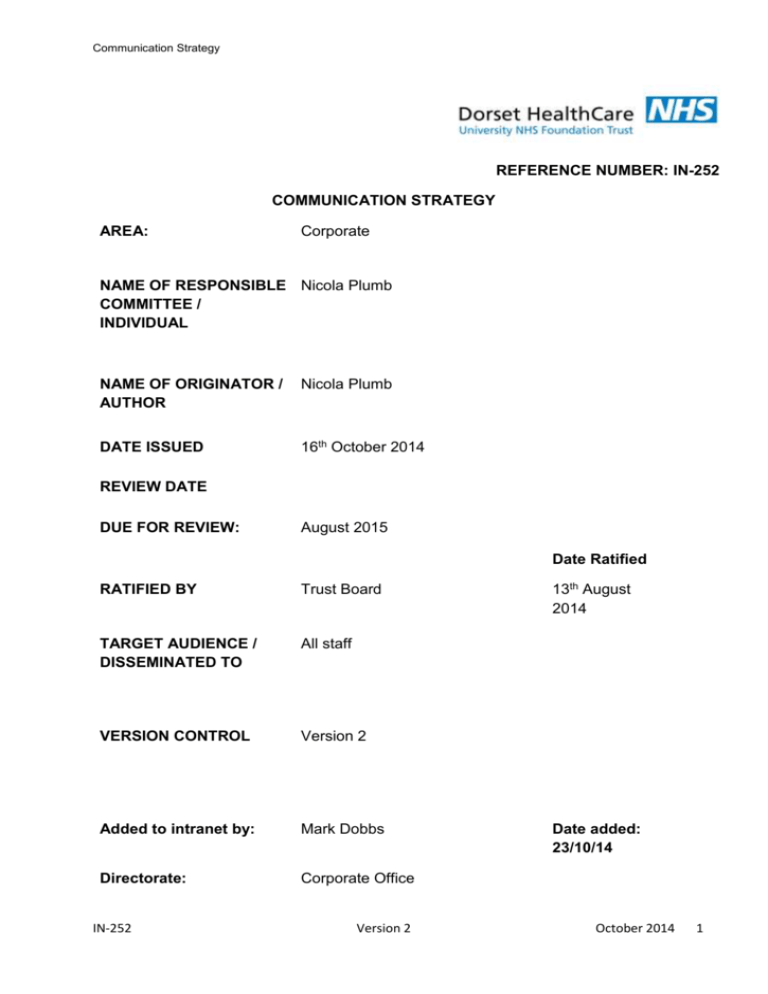
Communication Strategy REFERENCE NUMBER: IN-252 COMMUNICATION STRATEGY AREA: Corporate NAME OF RESPONSIBLE Nicola Plumb COMMITTEE / INDIVIDUAL NAME OF ORIGINATOR / AUTHOR Nicola Plumb DATE ISSUED 16th October 2014 REVIEW DATE DUE FOR REVIEW: August 2015 Date Ratified RATIFIED BY Trust Board TARGET AUDIENCE / DISSEMINATED TO All staff VERSION CONTROL Version 2 Added to intranet by: Mark Dobbs Directorate: Corporate Office IN-252 Version 2 13th August 2014 Date added: 23/10/14 October 2014 1 Communication Strategy Communications Strategy 2014-2017 IN-252 Version 2 October 2014 2 Communication Strategy Communications Strategy 2014-2017 1.0 Purpose of this document 2.0 Background 3.0 Role of Communications 4.0 Timing 5.0 Challenges 6.0 Principles 7.0 Objectives 8.0 Key work streams: 9.0 Internal communications Editorial and narrative Digital Media Events Brand identity Evaluation Appendix A: Action plan 2014/15 Appendix B: Related staff insights IN-252 Version 2 October 2014 3 Communication Strategy 1.0 PURPOSE OF THIS DOCUMENT This communications strategy sets out how a coordinated and consistent approach to our communications will support Dorset HealthCare to constantly improve the services it delivers to the people of Dorset and beyond. The document sets out some of the existing communications challenges, the principles of our approach, overarching communications objectives and the tools and channels we expect to adopt and strengthen. All of this will introduce a consistency of voice and aims to ensure consistently high quality standards in all of our communications activity. This is not a communications ‘and engagement’ strategy. It is a given that communications is about flows of information and not about broadcast. It is assumed that our internal and external communications activity is ‘two-way’ and interactive. The Participation Strategy deals with the way that we will co-produce with, and listen to, the voices of the people we serve and our partners. This is a three-year document and annual action plan that will be reviewed and updated annually, designed to support delivery of Dorset HealthCare’s strategic business objectives. 1.1 Related documents The communications strategy should be read alongside the strategies for participation and for organisational development. High quality, consistent communications channels are important for improving the flow of information and fundamental to supporting the creation of an open and transparent environment. The communications strategy should also be read alongside the Trust’s Blueprint published in May 2014. The Blueprint sets out the recent journey of the Trust and this document is designed to support delivery of our vision in the Blueprint and for Dorset HealthCare to become exemplary in all that it does. 2.0 BACKGROUND The Blueprint details recent improvements made at the Trust as a result of action taken by the Care Quality Commission and Monitor. By October 2014 the Trust expects to have recruited to the remaining board post and the new leadership team will work together, and with staff, to come back to the core purpose of Dorset HealthCare, why we exist and how we serve local people. The move to personalised, integrated locality working will address inflexible management structures and processes. A refreshed approach to communications will support that transition, flowing information across professional and functional boundaries and bringing to life an environment of openness, transparency and participation. Externally, the Trust is one of four large Foundation Trusts within Dorset and must actively compete to set out its offer to local people and staff, to build its membership and to ensure that it is responsive to need and held to account. IN-252 Version 2 October 2014 4 Communication Strategy The Trust has historically had a very small, dedicated in-house communications team, with access to external expertise as required. The creation of a board-level post to lead organisational development, participation and communications reflects a renewed focus and commitment to developing in these key areas. 3.0 THE ROLE OF COMMUNICATIONS Sharing clear, consistent and meaningful information is a critical objective but not an end in itself. High quality communications activity is everyone’s business and directly contributes to delivering high quality outcomes for those accessing our services. Clear information for service users, common understandings and expectations of our services, being held to account by those we serve and an engaged workforce are just some of the reasons to communicate clearly and consistently. A robust communications service sits alongside strong leaders throughout the organisation, who role model our behaviours and share information amongst and across teams, services and with service users. Corporate newsletters, patient information and a digital news service will never take the place of people talking to one another, whether that is within our teams, across teams or in the relationships formed between clinicians and patients and service users. 4.0 TIMING This is an ambitious document that also needs to be realistic in its objectives. We are reframing our communications alongside a new leadership team establishing its role and the structural transformation to integrated locality teams. This means we must revisit and ensure the effectiveness of our communications infrastructure, to support organisational changes and phase our communications development so that it is done in partnership with staff. We propose three distinct phases of activity: Phase one: August to December 2014: Planning and development of communications infrastructure, working with staff in localities to identify internal and external communications requirements. Phase two: January 2015 to March 2015: Testing and implementation of refreshed channels and products. Phase three: End March 2015: effective communications re-launch, including brand identity. Between August 2014 and end March 2015 we are developing the basic platforms and products from which to launch our more ambitious initiatives. 5.0 CHALLENGES Effective, integrated communications activity will raise the profile of the Trust, help to build relationships and can help to overcome a wide variety of challenges where clear and consistent information establishes trust and understanding. IN-252 Version 2 October 2014 5 Communication Strategy Some of the key challenges our communications activity will help the Trust to address include: Supporting staff through the establishment of 13 integrated locality teams at the same time as building a strong Dorset HealthCare brand that amplifies our values Building trust and empowering clinical staff, undoing a top-down management culture Attracting staff to join the Trust, becoming an employer of choice and projecting a strong employer brand through the county and beyond Understanding the people we serve and what they want to develop with us Establishing voice and position in the local health community and beyond 6.0 PRINCIPLES OF OUR COMMUNICATIONS We are single-minded about patients and quality: our communications will constantly promote quality and single-mindedness for patients and service users. We will be accessible, one size won’t fit all: we will tell our story consistently, with conviction and in meaningful language, accessible to all. Our communications will seek to set the vision, articulate the common fixed points in development, map the critical moves and set out the golden rules (openness and transparency). Locality first: we will seek to achieve consistency without control, using brand Dorset HealthCare to support and amplify our 13 localities We embrace digital: we will encourage everyone to tell their Dorset HealthCare story: twitter, blogs, Facebook, YouTube and other digital channels empower people to connect, without hierarchy, function or role. We will amplify those stories. We will be open and transparent in real-time: we will coordinate our channels and information so that everyone receives the same information within the same time frame. We will nurture collaboration, encourage networks and connections and work in partnership: bright lights, innovators and early adopters will be encouraged to share and inspire, gathering others around them to constantly improve for our patients. We will work in partnership as often as possible, to avoid duplication and achieve a greater outcome for the sum total for our efforts. IN-252 Version 2 October 2014 6 Communication Strategy 7.0 OVERARCHING COMMUNICATIONS OBJECTIVES To raise awareness of who we are and the services we deliver and position Dorset HealthCare as the trusted local provider of personalised, integrated, locality services. To ensure consistent and timely internal communications so that information flows through and across teams, functions and services. To improve the quality and accessibility of the information we share and exchange with our patients and service users, partners and local communities. To develop the communications skills and capacity of Dorset HealthCare and its people. Complementary communications strategies and action plans for specific initiatives or issues will be developed according to the principles of this strategy, including for example, infection control and winter vaccination campaigns. These plans and those developed to support the above overarching objectives will include stretch targets, key performance indicators, where appropriate, and mechanisms to evaluate effectiveness, reach, profile and so on. 8.0 KEY WORKSTREAMS Internal communications Our internal communications infrastructure is in need of renewal and currently unable to meet the needs of an organisation with a workforce of 5000 people working from more than 250 sites in Dorset. Robust and far reaching internal communications channels will enable us to involve staff in the organisation’s development, encourage people to work across traditional boundaries and promote awareness of our strategic objectives and common corporate goals. We will promote co-operation and collaboration around key issues, to unleash creativity and drive innovation and learning. We will develop a standalone internal communications plan that will refresh our channels and include, but not be limited to: the intranet, staff briefings, senior team briefings, raising board visibility, noticeboards, induction, staff recognition and celebration, Roundup and other newsletters, Trustlink, podcasting, web chats and discussion boards. Editorial and narrative We will craft a strong voice for the Trust, with a quality improvement narrative at its core. We will be clear on our proposition for staff and for local people and will translate these into loud key messages that will constantly reinforce who we are and what we stand for. We will use story-telling and narrative to bring the organisation to life through the 5000 voices of our staff, our patients and service users. IN-252 Version 2 October 2014 7 Communication Strategy Digital A separate digital strategy will set our vision for the future as we improve our existing platforms in a priority first step. The digital strategy will set out how we will operate across web and social media platforms and make use of applications to share, engage, interact and co-produce with those we serve and our partners. Effective use of digital will allow us to: Listen: understand what people are saying about us and our services and respond to them in real-time. Share and explain: publish information and data, promote standards and innovation, report on service improvements, and explain the decisions we have made. Amplify: provide content that is reusable, which can be adopted and used across partner and media channels, raising our profile and reach; including videos, blogs and audio. Engage: create public and private spaces for co-production, sharing and innovation; including webexes, Google Hangouts and other collaborative platforms. Media A rolling programme of media activity will amplify our successes and raise our profile, both locally and nationally. The overarching media plan will map outlets, journalists and columnists, enabling us to target our activity; while a forward planning grid will identify key milestones and achievements, ensuring we miss no opportunity. We will identify staff who can talk to journalists with confidence and passion, projecting our clinical leaders and positioning Dorset HealthCare as the local expert for the delivery of integrated, locality working. We will target local and regional media and, when appropriate, trade and national outlets. A combination of press briefings, news stories, features, interviews and fireside chats will deliver a steady state of coverage in local and regional press, raising awareness with local people and demonstrating to staff that we will always seek to recognise and celebrate their achievements. Events, meetings, forums and conferences We will plug ourselves in to the local community, identifying opportunities to contribute, share and engage, listen and learn. We will seek to be visible at the heart of the communities we serve, attending school fetes, partner events, summer festivals and similar. This will keep us connected to our partners and local people, drive collaboration and forge strong relationships. Local people will have the information to hold us to account and know how they can participate in our work. Brand identity We will develop a strong visual identity for Dorset HealthCare that reflects and promotes our organisational integrity and amplifies our vision and purpose. We will give staff the knowledge and tools to produce high quality and consistent products, without having to rely on external expertise. IN-252 Version 2 October 2014 8 Communication Strategy 9.0 EVALUATION We will need a range of mechanisms to assess the impact of our activity, specially designed to evaluate individual channels, products, campaigns or initiatives. For example, there are a range of sophisticated tools and metrics to evaluate digital activity, from reach and impact, to tone of voice and website usage. We will develop a scorecard of metrics to routinely evaluate progress against this strategy and for those individual action plans and campaigns to come. The commitment here is to plan for evaluation in advance, so that we may collect the appropriate data and insight. IN-252 Version 2 October 2014 9 Communication Strategy ANNEX A: 2014/15 Action plan To raise awareness of who we are and the services we deliver and position Dorset HealthCare as the trusted local provider of personalised, integrated, locality services. Develop and deliver an integrated media strategy including evaluation and monitoring, identification of annual milestones and robust systems for out-of-hours and major incidents August to December 2014 Develop and deliver a targeted recruitment marketing strategy to amplify Dorset HealthCare and attract new staff to the Trust August to December 2014 Develop a stakeholder engagement strategy including a comprehensive programme of events and detailed mapping of our stakeholders and partners January to March 2015 Develop an online Directory of Services for GPs, partners and the public Complete end December 2014 Co-produce with staff and widely share a narrative for Dorset HealthCare, including a regularly updated introductory presentation and key facts and figures January to March 2015 Digital strategy development including, securing external expertise to work with staff on redevelopment and re-launch of the Trust website Re-launch end March 2015 To ensure consistent and timely internal communications so that information flows through and across teams, functions and services. Convene an internal communications working group to explore existing channels and work with staff to co-produce the infrastructure of the future August to December 2014 Secure external expertise to work with the Trust on redevelopment of its intranet and re-launch with an enterprise social network August to December 2014; testing January 2015 Develop and deliver integrated internal communications plan, including activities to specifically involve staff in development of Quality priorities, the Cost Improvement Programme and ideas generation August to December 2014 To improve the quality and accessibility of the information we share and exchange with our patients and service users, partners and local communities. Identify and review existing resources as far as possible, including corporate products and service-led products such as IN-252 Version 2 August to October 2014 10 Communication Strategy templates, leaflets and digital resources December 2015 Convene a group of staff and patients, service users and carers, with representation from each locality to review existing patient information across service lines and articulate our needs moving forward August to December 2015 To develop the communications skills and capacity of Dorset HealthCare and its people. Design and resource a corporate communications function August to December 2014 Investigate roster arrangements to achieve best value for money for those specialist services we will always outsource, such as design, print and digital development January to March 2015 Introduce a programme of communications training and development opportunities available to all staff in specialist areas such as digital literacy, web content uploads and media interviewing skills January to March 2015 Refresh existing corporate document and presentation templates such as ppt and word to ensure staff can easily produce high quality products January to March 2015 Review existing, and ensure we provide appropriate communications policies in order to guide and support activity January to March 2015 IN-252 Version 2 October 2014 11 Communication Strategy APPENDIX B: Related staff insights At a series of engagement events in December 2013 and January 2014 staff were invited to feedback about various aspects of their experience of the Trust. Below is a selection of the comments that were used to inform this strategy. “More positive stories about our services in the local press are needed to counter balance the ‘bad news’ stories nationally to improve staff morale” “Staff want to see a “new unified corporate image to help leave the past behind” “…no one will give us a straight answer.” “We need a new Trust image. What is our image and branding anyway? I would like to feel excited and motivated by my organisation but I don’t. Let’s start afresh and create an image for ourselves that unites us all.” “Capture the enthusiasm and dedication that practitioners continue to demonstrate” “Messages get lost by the time it gets to Team Meetings. Staff would appreciate a direct conversation too.” “Need to raise GP awareness of services we offer/provide.” “Communications with staff is poor and information is poorly organised and inconsistent; phone directory, induction and intranet particularly poor; lack of consistent and up to date information.” “We need an identity we can be proud of” “A better website similar to search engines – put in a word and it gives you what you want, ideas, something vaguely similar.” “Interactive directory on the web, thoroughly cross referenced with name, job title, location etc. Put all Trust localities in a geographic map form on the web” “How it feels as if we have no voice” “What about a leaflet about Dorset HealthCare that we give to patients at first point of contact, we have a service leaflet but not a DHC one” “What about an online map of who’s who” “We need a new Trust identity, name and rebranding” “Networking and conferences to share best practice” “Training with GPs to promote awareness and understanding of each other’s roles” IN-252 Version 2 October 2014 12
